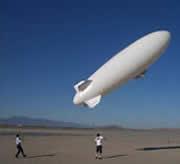 The smart balloon can find its own way and steer out of bad weather.© JPL/NASA
The smart balloon can find its own way and steer out of bad weather.© JPL/NASAAn intelligent floating robot could help to explore Saturn's moon Titan, following flight tests that prove it can survey large areas of land completely autonomously. The aerobot is even smart enough to avoid dangerous turbulence.
"After the Huygens probe returned those stunning pictures of Titan's surface, there's been a lot of interest in another mission," says Alberto Elfes, a robotics expert at the Jet Propulsion Laboratory in Pasadena, California. He and his colleagues think that their aerobot could spend months cruising through the moon's atmosphere, mapping the surface and collecting samples.
"Aerial vehicles fill the gap between orbiters and ground-based robots," Elfes explains. Orbiting satellites can map large areas of moons or planets, but resolving small features on the surface is extremely difficult, especially if they are obscured beneath a cloudy atmosphere such as Titan's.
And although rovers such as Spirit and Opportunity can see a lot more detail, they have a very limited range and rely on constant supervision from mission managers back home.
Good plot
 Read our blog from the Space 2005 conference here.
Read our blog from the Space 2005 conference here.The team tested the artificial intelligence of its 11-metre-long airship over a dry lake bed in El Mirage, California, last year. The craft was able to explore areas that lay several kilometres away from its launch site in less than an hour, working out its own route between sites of interest that had been chosen by scientists before the flight.
The robot corrected its path whenever it was blown off course, and could also assess danger from air turbulence by sensing wind speeds, changing its altitude to reach calmer air when necessary. Elfes presented the team's results on 31 August at the Space 2005 conference in Long Beach, California.
The aerobot currently relies on the Global Positioning System, or GPS, to plot its course, but a Titan explorer would not have that luxury. So the team has trained the robot to track its own position using the photographs it takes of the ground.
Forest fliers
Elfes started work on the autonomous airship in the late 1990s, while he was director of the Automation Institute in Campinas, Brazil. He hoped that the craft would be used to monitor the health of the country's rainforests. But although it could find its own way from place to place, that version of the aerobot still needed a human operator to get it out of trouble.
As radio signals take about 90 minutes to travel from Earth to Titan, and can be blocked for days at a time by Saturn, developing better artificial intelligence was essential for any future mission. "You really need a system smart enough to detect danger and react to it," says Elfes.
Projects in the air
ADVERTISEMENT
While his team works on the aerobot's brains, a sister project at the Jet Propulsion Lab is developing a tough helium balloon that could be flown to Titan and inflated on arrival. The craft would avoid landing, but could skim low enough to drop probes or sampling devices on the ground.
This summer, aerobot's team got further funding to develop a full mission proposal, which may lead to a launch in 2012. Elfes says that the aerobot could do active duty on other planets with substantial atmospheres, such as Venus.
But similar craft might be used on Earth much sooner, he adds. Deployed at high altitude, they would provide a cheaper alternative to telecommunication satellites, and could be particularly useful for quickly re-establishing lines of communication over disaster areas.
